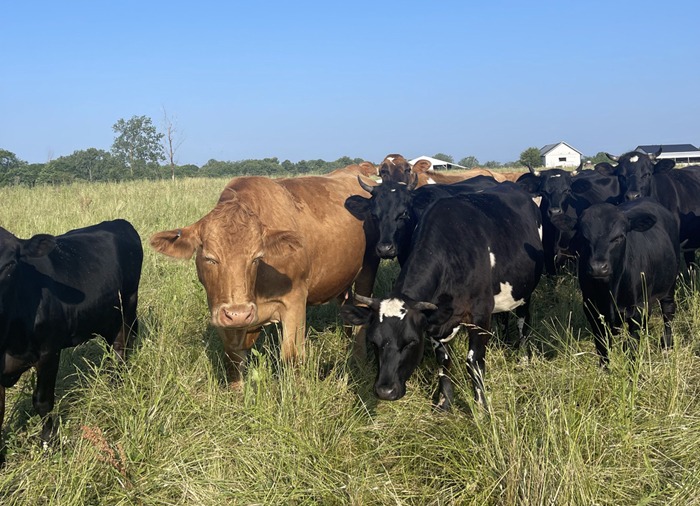The growing season creates opportunities for corn and soybean producers in the Corn Belt to showcase cutting-edge technology and high-performing plant varieties, part of what makes the Midwest world-renowned for our farm productivity.

Finn Woodings, DCB Team Member, had a bucket for soil sampling as part of DCB’s research team efforts, and the cattle came over to visit him and see if they would be fed.
Photo by Finn Woodings.
What would happen if we became even more productive by growing a greater variety of crops and grazing more livestock?
That’s one of the questions the Diverse Corn Belt Project (DCB) seeks to answer.
DCB is a five-year, multi-faceted study that explores opportunities for and barriers in adding more crops and grazed livestock to rotations in the Corn Belt. Researchers and educators from 15 universities and organizations are sparking conversations with stakeholders and conducting research in the field. Iowa, Illinois, and Indiana comprise the study area for this $10 million grant from the U.S. Department of Agriculture’s National Institute of Food and Agriculture.

Dr. Linda Prokopy, Horticulture and Landscape Architecture Department Head and Professor at Purdue University. Photo Provided by Dr. Prokopy.
Dr. Linda Prokopy, Horticulture and Landscape Architecture Department Head and Professor at Purdue University, leads the project. She says that DCB grew out of a need to understand the opportunities and barriers that face farmers, food processors, members of rural communities, and other Corn Belt stakeholders.
“The goal of the Diverse Corn Belt Project is not to transform the landscape in five years,” Prokopy says. “It’s to initiate conversation on visions and framework needed to create that transformation.”
The project connects several agricultural and social science disciplines, from entomology to education, to learn the best steps for diversifying the landscape and becoming more resilient.
“We don’t know the solution,” Prokopy says. “Our goal is to start finding concrete options for diversification and understanding the real-world agronomic, economic, social, infrastructure, and policy changes that could make them viable.”
Resilience is a concept that has been brought to the forefront with recent health and environmental challenges, both globally and regionally. Supply chain complications during the COVID-19 pandemic provided insight into gaps in our food system. Regionally, dust storms in Illinois in May 2023 blinded interstate drivers and caused collisions of more than 70 vehicles. Seven people were killed.
That’s where the information DCB is gathering comes in. There are three different levels DCB is examining:
- Farm-level diversity: expanding rotations beyond corn and soybeans to include small grains, forages, perennials, vegetables, horticulture crops, grazed livestock, trees, and more. In-field, we are comparing soil, water, and insects that are part of corn and soybean rotations and those that are part of diversified systems.
- Market-level diversity: providing several types of markets for both producers and consumers, meeting diverse needs across the community.
- Landscape-level diversity: adopting systems of resilient intensification that meet goals of profitability, yield, and ecosystem services.
Along with resilience, DCB also is examining the economic opportunities the Corn Belt can offer with diversified farms, markets, and landscapes.
“Concrete steps toward diversification have the potential to create thriving economic activity in rural Midwestern communities,” Prokopy says, “attracting the next generation back to farms and rural communities with new energy and diverse perspectives.”
Prokopy says that examining each of these levels will broaden the opportunities for residents of the Corn Belt.

Soybean plants grow among corn residue in a Midwestern field. This is an example of a field where the DCB Team took soil, water, and/or insect samples.
Photo by Finn Woodings.
Stakeholders in DCB include farmers, policy makers, students, processors in the food, feed, fuel, and fiber industries, economic development professionals, agricultural professionals such as crop advisers, ag lenders, and input suppliers, and non-operating landowners.
In future posts, learn about the project’s many components, from water quality testing to developing modules for high school teachers to talk about diversified agriculture. DCB team members also have published results in several journals. For resources on diversification, visit our External Resources page.
